Report on Creative Thinking and Innovation in Tesla's Energy Solutions
VerifiedAdded on 2023/03/30
|17
|2919
|499
Report
AI Summary
This report delves into the application of creative thinking and innovation models to address Tesla's challenge of storing solar energy effectively. It employs the five-stage Divergent-Convergent Model, along with deliberate creative thinking techniques such as parallel thinking, Six Thinking Hats, radiant thinking, and mind mapping. The report defines the problem, explores potential solutions like hydrogen energy conversion, ideates using brainstorming and SCAMMPERR, and designs a potential implementation strategy. It ultimately recommends solutions for Tesla to enhance its sustainable energy storage capabilities, focusing on cost-efficiency, durability, and environmental impact. The report provides a detailed analysis of the challenges, constraints, and opportunities associated with adopting innovative energy storage solutions within Tesla's operations.
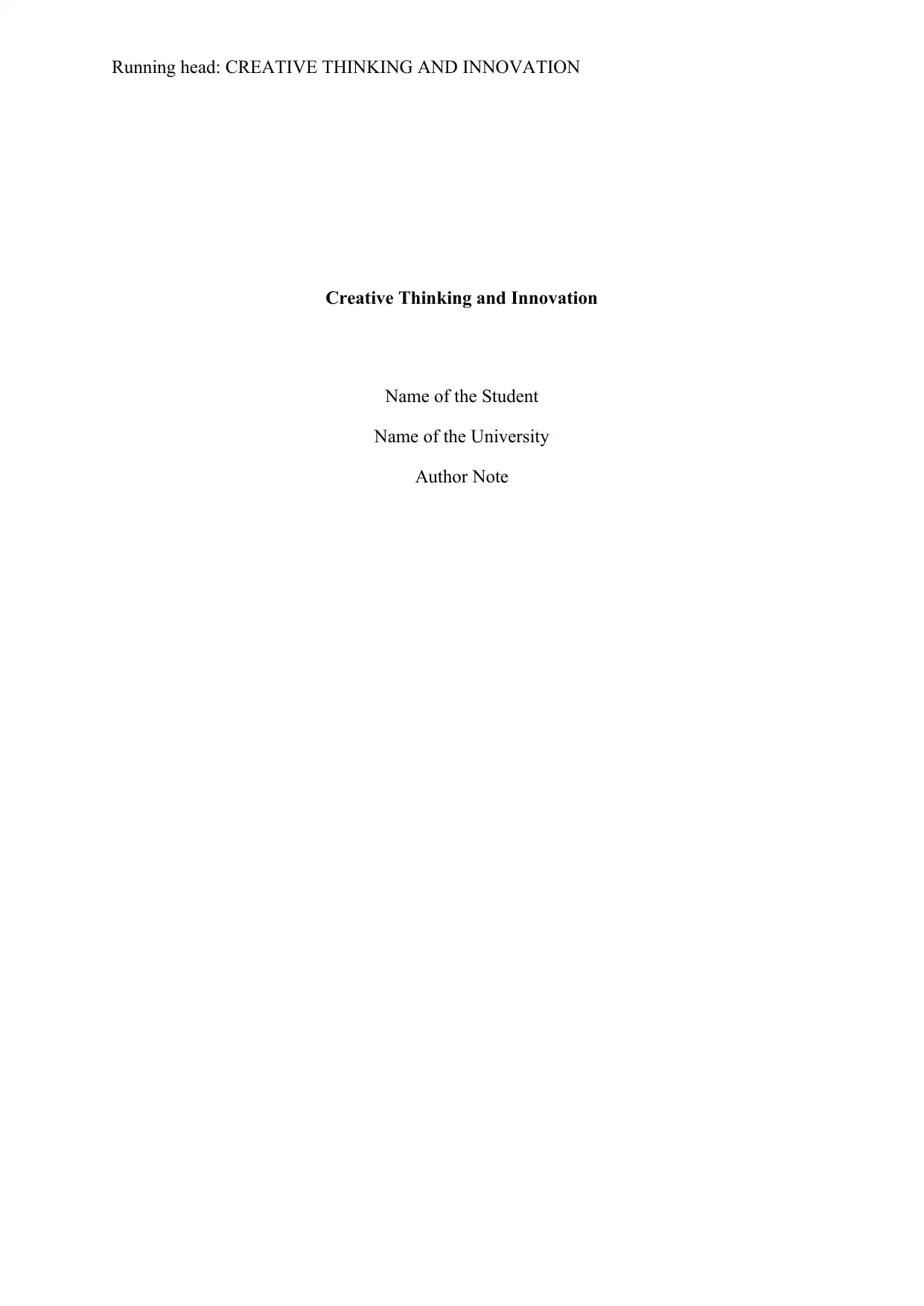
Running head: CREATIVE THINKING AND INNOVATION
Creative Thinking and Innovation
Name of the Student
Name of the University
Author Note
Creative Thinking and Innovation
Name of the Student
Name of the University
Author Note
Paraphrase This Document
Need a fresh take? Get an instant paraphrase of this document with our AI Paraphraser
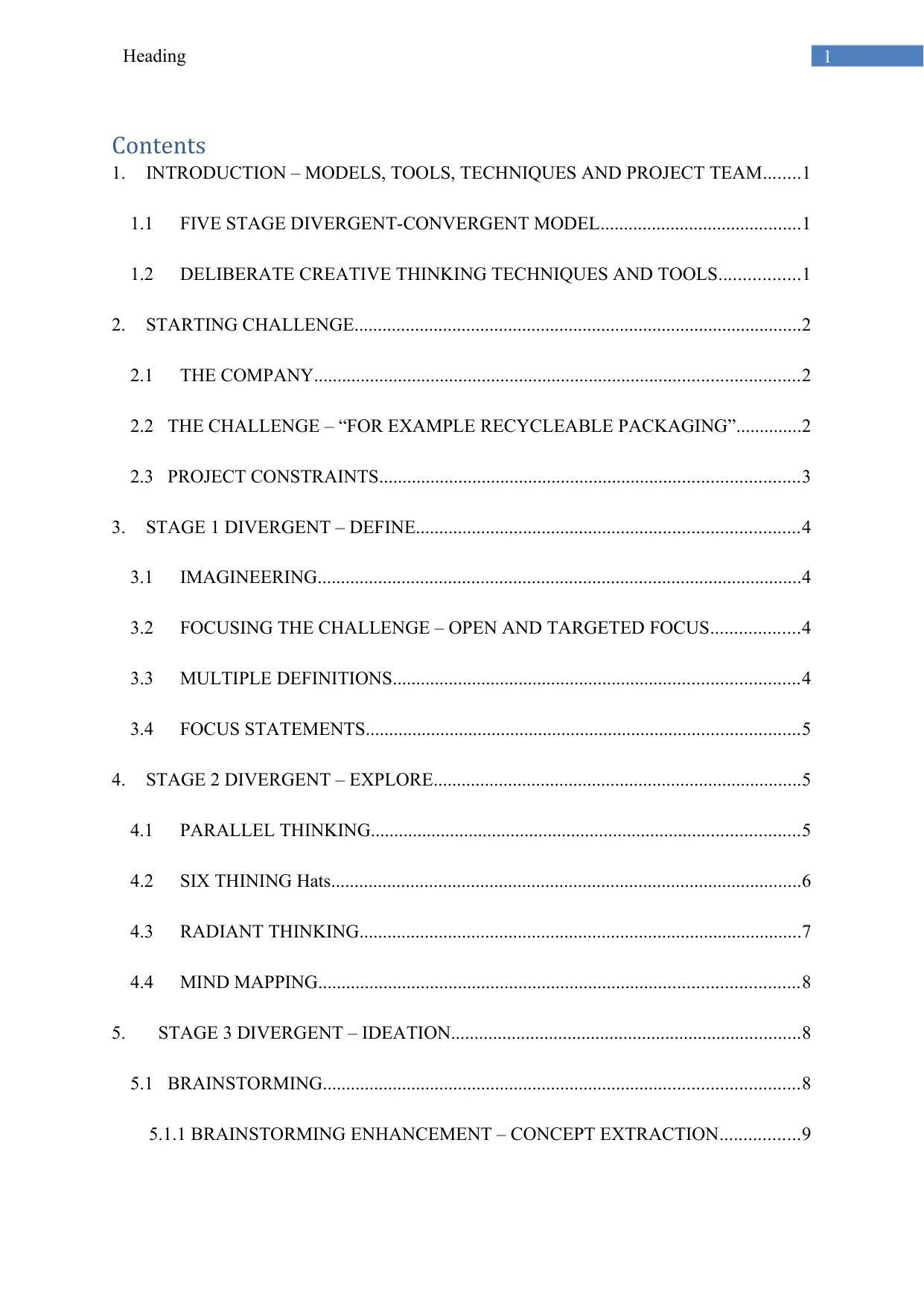
1Heading
Contents
1. INTRODUCTION – MODELS, TOOLS, TECHNIQUES AND PROJECT TEAM........1
1.1 FIVE STAGE DIVERGENT-CONVERGENT MODEL...........................................1
1.2 DELIBERATE CREATIVE THINKING TECHNIQUES AND TOOLS.................1
2. STARTING CHALLENGE................................................................................................2
2.1 THE COMPANY........................................................................................................2
2.2 THE CHALLENGE – “FOR EXAMPLE RECYCLEABLE PACKAGING”..............2
2.3 PROJECT CONSTRAINTS..........................................................................................3
3. STAGE 1 DIVERGENT – DEFINE..................................................................................4
3.1 IMAGINEERING........................................................................................................4
3.2 FOCUSING THE CHALLENGE – OPEN AND TARGETED FOCUS...................4
3.3 MULTIPLE DEFINITIONS.......................................................................................4
3.4 FOCUS STATEMENTS.............................................................................................5
4. STAGE 2 DIVERGENT – EXPLORE...............................................................................5
4.1 PARALLEL THINKING............................................................................................5
4.2 SIX THINING Hats.....................................................................................................6
4.3 RADIANT THINKING...............................................................................................7
4.4 MIND MAPPING.......................................................................................................8
5. STAGE 3 DIVERGENT – IDEATION...........................................................................8
5.1 BRAINSTORMING......................................................................................................8
5.1.1 BRAINSTORMING ENHANCEMENT – CONCEPT EXTRACTION.................9
Contents
1. INTRODUCTION – MODELS, TOOLS, TECHNIQUES AND PROJECT TEAM........1
1.1 FIVE STAGE DIVERGENT-CONVERGENT MODEL...........................................1
1.2 DELIBERATE CREATIVE THINKING TECHNIQUES AND TOOLS.................1
2. STARTING CHALLENGE................................................................................................2
2.1 THE COMPANY........................................................................................................2
2.2 THE CHALLENGE – “FOR EXAMPLE RECYCLEABLE PACKAGING”..............2
2.3 PROJECT CONSTRAINTS..........................................................................................3
3. STAGE 1 DIVERGENT – DEFINE..................................................................................4
3.1 IMAGINEERING........................................................................................................4
3.2 FOCUSING THE CHALLENGE – OPEN AND TARGETED FOCUS...................4
3.3 MULTIPLE DEFINITIONS.......................................................................................4
3.4 FOCUS STATEMENTS.............................................................................................5
4. STAGE 2 DIVERGENT – EXPLORE...............................................................................5
4.1 PARALLEL THINKING............................................................................................5
4.2 SIX THINING Hats.....................................................................................................6
4.3 RADIANT THINKING...............................................................................................7
4.4 MIND MAPPING.......................................................................................................8
5. STAGE 3 DIVERGENT – IDEATION...........................................................................8
5.1 BRAINSTORMING......................................................................................................8
5.1.1 BRAINSTORMING ENHANCEMENT – CONCEPT EXTRACTION.................9
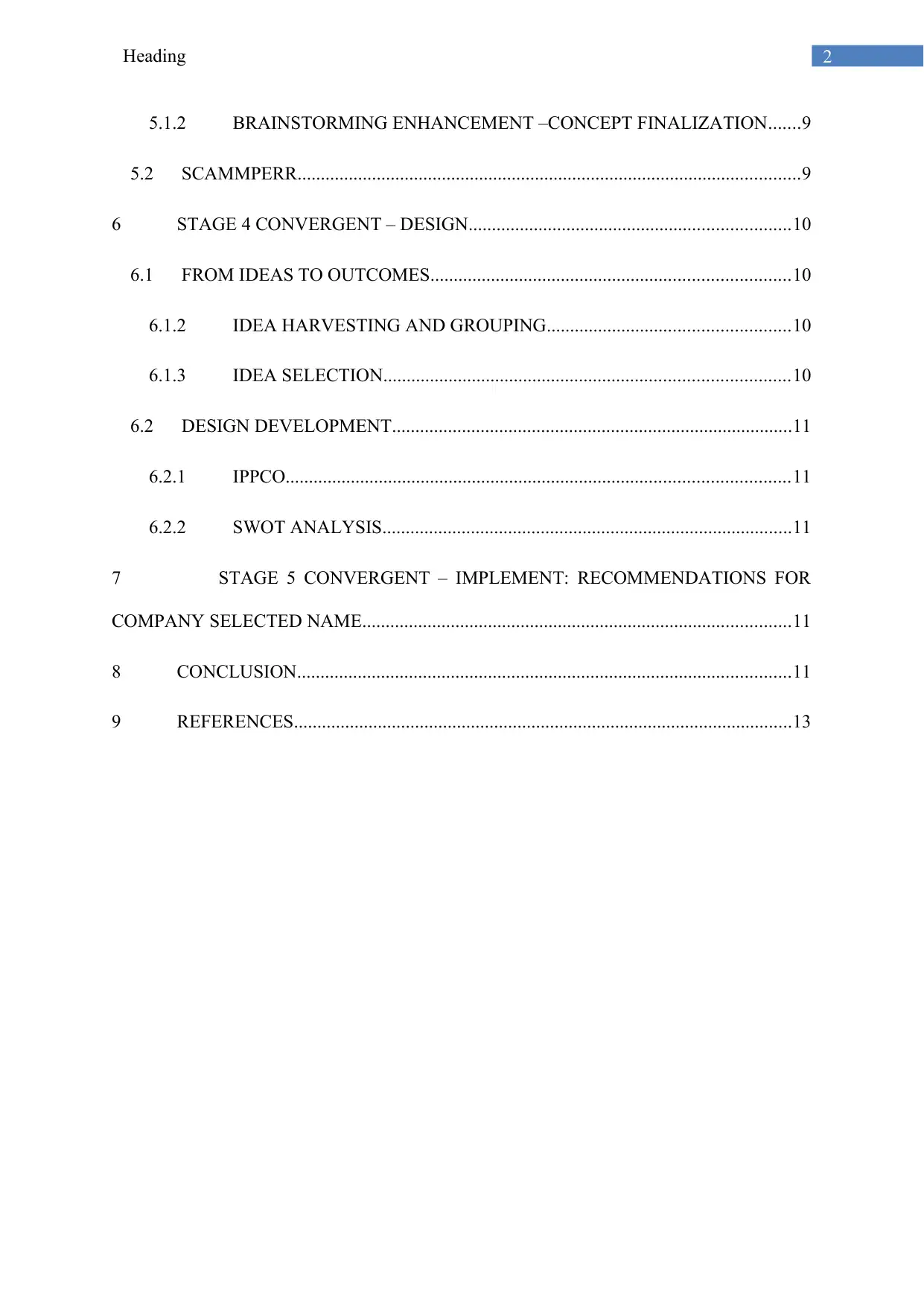
2Heading
5.1.2 BRAINSTORMING ENHANCEMENT –CONCEPT FINALIZATION.......9
5.2 SCAMMPERR............................................................................................................9
6 STAGE 4 CONVERGENT – DESIGN.....................................................................10
6.1 FROM IDEAS TO OUTCOMES.............................................................................10
6.1.2 IDEA HARVESTING AND GROUPING....................................................10
6.1.3 IDEA SELECTION.......................................................................................10
6.2 DESIGN DEVELOPMENT......................................................................................11
6.2.1 IPPCO............................................................................................................11
6.2.2 SWOT ANALYSIS........................................................................................11
7 STAGE 5 CONVERGENT – IMPLEMENT: RECOMMENDATIONS FOR
COMPANY SELECTED NAME............................................................................................11
8 CONCLUSION..........................................................................................................11
9 REFERENCES...........................................................................................................13
5.1.2 BRAINSTORMING ENHANCEMENT –CONCEPT FINALIZATION.......9
5.2 SCAMMPERR............................................................................................................9
6 STAGE 4 CONVERGENT – DESIGN.....................................................................10
6.1 FROM IDEAS TO OUTCOMES.............................................................................10
6.1.2 IDEA HARVESTING AND GROUPING....................................................10
6.1.3 IDEA SELECTION.......................................................................................10
6.2 DESIGN DEVELOPMENT......................................................................................11
6.2.1 IPPCO............................................................................................................11
6.2.2 SWOT ANALYSIS........................................................................................11
7 STAGE 5 CONVERGENT – IMPLEMENT: RECOMMENDATIONS FOR
COMPANY SELECTED NAME............................................................................................11
8 CONCLUSION..........................................................................................................11
9 REFERENCES...........................................................................................................13
⊘ This is a preview!⊘
Do you want full access?
Subscribe today to unlock all pages.

Trusted by 1+ million students worldwide
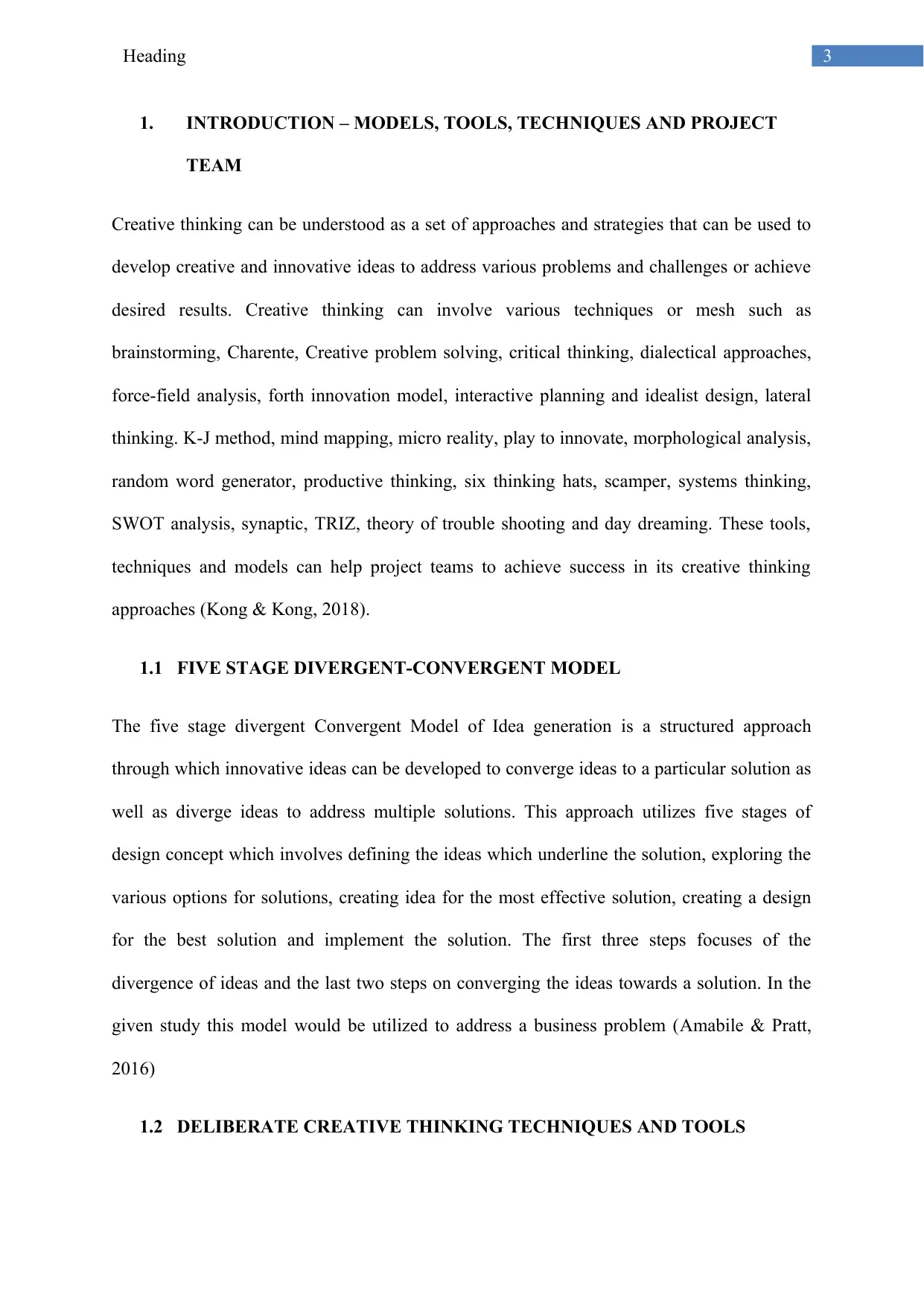
3Heading
1. INTRODUCTION – MODELS, TOOLS, TECHNIQUES AND PROJECT
TEAM
Creative thinking can be understood as a set of approaches and strategies that can be used to
develop creative and innovative ideas to address various problems and challenges or achieve
desired results. Creative thinking can involve various techniques or mesh such as
brainstorming, Charente, Creative problem solving, critical thinking, dialectical approaches,
force-field analysis, forth innovation model, interactive planning and idealist design, lateral
thinking. K-J method, mind mapping, micro reality, play to innovate, morphological analysis,
random word generator, productive thinking, six thinking hats, scamper, systems thinking,
SWOT analysis, synaptic, TRIZ, theory of trouble shooting and day dreaming. These tools,
techniques and models can help project teams to achieve success in its creative thinking
approaches (Kong & Kong, 2018).
1.1 FIVE STAGE DIVERGENT-CONVERGENT MODEL
The five stage divergent Convergent Model of Idea generation is a structured approach
through which innovative ideas can be developed to converge ideas to a particular solution as
well as diverge ideas to address multiple solutions. This approach utilizes five stages of
design concept which involves defining the ideas which underline the solution, exploring the
various options for solutions, creating idea for the most effective solution, creating a design
for the best solution and implement the solution. The first three steps focuses of the
divergence of ideas and the last two steps on converging the ideas towards a solution. In the
given study this model would be utilized to address a business problem (Amabile & Pratt,
2016)
1.2 DELIBERATE CREATIVE THINKING TECHNIQUES AND TOOLS
1. INTRODUCTION – MODELS, TOOLS, TECHNIQUES AND PROJECT
TEAM
Creative thinking can be understood as a set of approaches and strategies that can be used to
develop creative and innovative ideas to address various problems and challenges or achieve
desired results. Creative thinking can involve various techniques or mesh such as
brainstorming, Charente, Creative problem solving, critical thinking, dialectical approaches,
force-field analysis, forth innovation model, interactive planning and idealist design, lateral
thinking. K-J method, mind mapping, micro reality, play to innovate, morphological analysis,
random word generator, productive thinking, six thinking hats, scamper, systems thinking,
SWOT analysis, synaptic, TRIZ, theory of trouble shooting and day dreaming. These tools,
techniques and models can help project teams to achieve success in its creative thinking
approaches (Kong & Kong, 2018).
1.1 FIVE STAGE DIVERGENT-CONVERGENT MODEL
The five stage divergent Convergent Model of Idea generation is a structured approach
through which innovative ideas can be developed to converge ideas to a particular solution as
well as diverge ideas to address multiple solutions. This approach utilizes five stages of
design concept which involves defining the ideas which underline the solution, exploring the
various options for solutions, creating idea for the most effective solution, creating a design
for the best solution and implement the solution. The first three steps focuses of the
divergence of ideas and the last two steps on converging the ideas towards a solution. In the
given study this model would be utilized to address a business problem (Amabile & Pratt,
2016)
1.2 DELIBERATE CREATIVE THINKING TECHNIQUES AND TOOLS
Paraphrase This Document
Need a fresh take? Get an instant paraphrase of this document with our AI Paraphraser
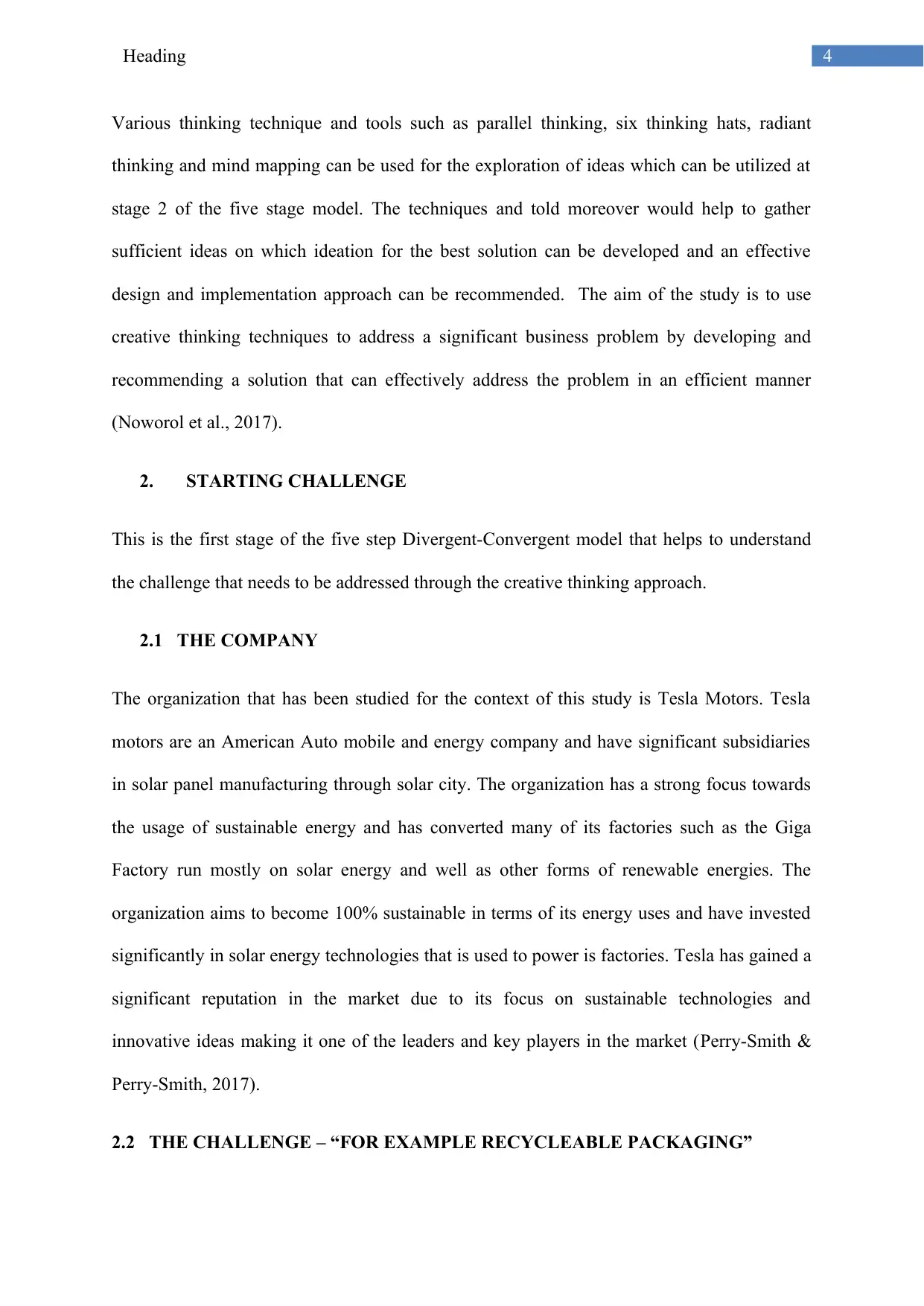
4Heading
Various thinking technique and tools such as parallel thinking, six thinking hats, radiant
thinking and mind mapping can be used for the exploration of ideas which can be utilized at
stage 2 of the five stage model. The techniques and told moreover would help to gather
sufficient ideas on which ideation for the best solution can be developed and an effective
design and implementation approach can be recommended. The aim of the study is to use
creative thinking techniques to address a significant business problem by developing and
recommending a solution that can effectively address the problem in an efficient manner
(Noworol et al., 2017).
2. STARTING CHALLENGE
This is the first stage of the five step Divergent-Convergent model that helps to understand
the challenge that needs to be addressed through the creative thinking approach.
2.1 THE COMPANY
The organization that has been studied for the context of this study is Tesla Motors. Tesla
motors are an American Auto mobile and energy company and have significant subsidiaries
in solar panel manufacturing through solar city. The organization has a strong focus towards
the usage of sustainable energy and has converted many of its factories such as the Giga
Factory run mostly on solar energy and well as other forms of renewable energies. The
organization aims to become 100% sustainable in terms of its energy uses and have invested
significantly in solar energy technologies that is used to power is factories. Tesla has gained a
significant reputation in the market due to its focus on sustainable technologies and
innovative ideas making it one of the leaders and key players in the market (Perry-Smith &
Perry-Smith, 2017).
2.2 THE CHALLENGE – “FOR EXAMPLE RECYCLEABLE PACKAGING”
Various thinking technique and tools such as parallel thinking, six thinking hats, radiant
thinking and mind mapping can be used for the exploration of ideas which can be utilized at
stage 2 of the five stage model. The techniques and told moreover would help to gather
sufficient ideas on which ideation for the best solution can be developed and an effective
design and implementation approach can be recommended. The aim of the study is to use
creative thinking techniques to address a significant business problem by developing and
recommending a solution that can effectively address the problem in an efficient manner
(Noworol et al., 2017).
2. STARTING CHALLENGE
This is the first stage of the five step Divergent-Convergent model that helps to understand
the challenge that needs to be addressed through the creative thinking approach.
2.1 THE COMPANY
The organization that has been studied for the context of this study is Tesla Motors. Tesla
motors are an American Auto mobile and energy company and have significant subsidiaries
in solar panel manufacturing through solar city. The organization has a strong focus towards
the usage of sustainable energy and has converted many of its factories such as the Giga
Factory run mostly on solar energy and well as other forms of renewable energies. The
organization aims to become 100% sustainable in terms of its energy uses and have invested
significantly in solar energy technologies that is used to power is factories. Tesla has gained a
significant reputation in the market due to its focus on sustainable technologies and
innovative ideas making it one of the leaders and key players in the market (Perry-Smith &
Perry-Smith, 2017).
2.2 THE CHALLENGE – “FOR EXAMPLE RECYCLEABLE PACKAGING”
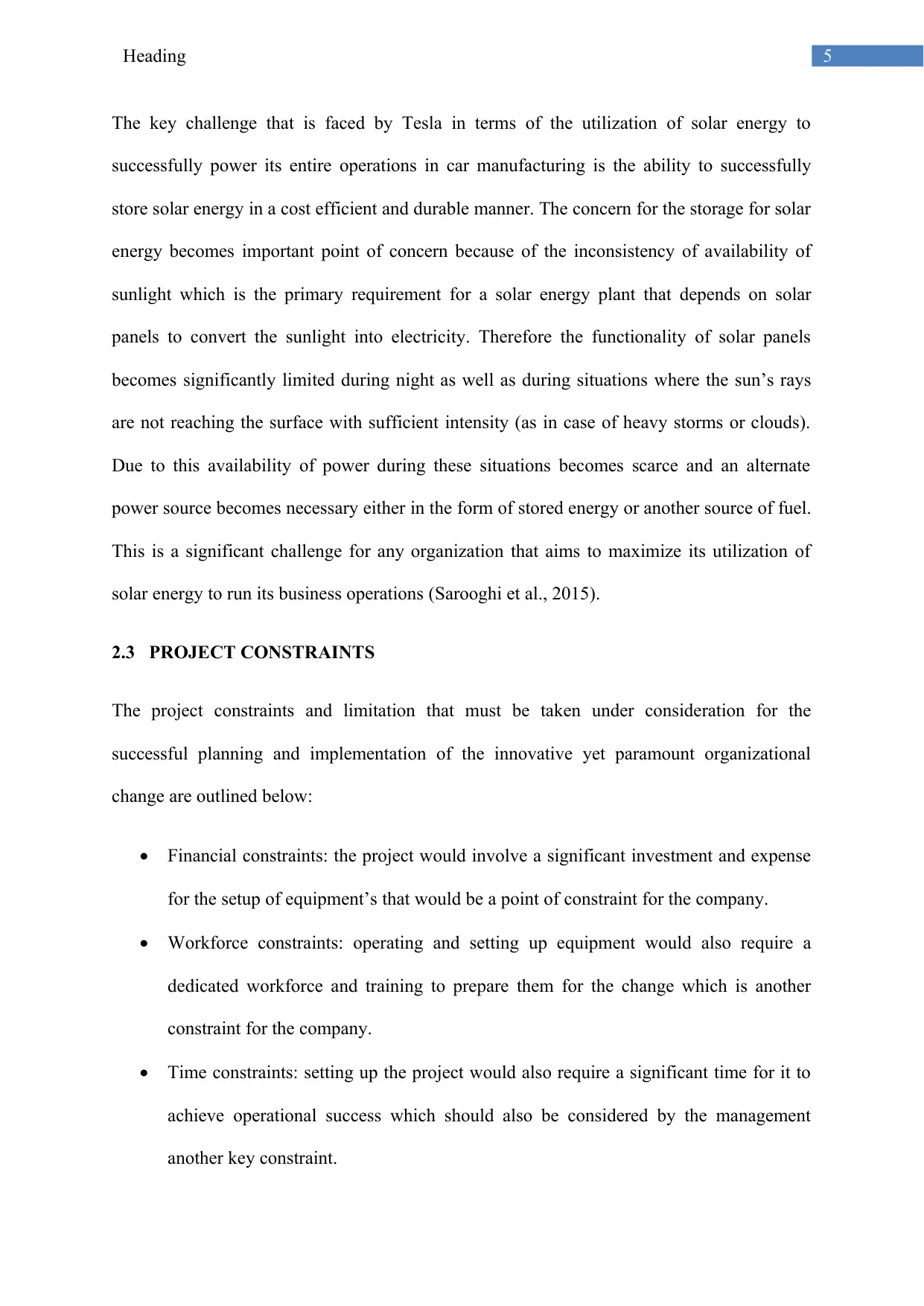
5Heading
The key challenge that is faced by Tesla in terms of the utilization of solar energy to
successfully power its entire operations in car manufacturing is the ability to successfully
store solar energy in a cost efficient and durable manner. The concern for the storage for solar
energy becomes important point of concern because of the inconsistency of availability of
sunlight which is the primary requirement for a solar energy plant that depends on solar
panels to convert the sunlight into electricity. Therefore the functionality of solar panels
becomes significantly limited during night as well as during situations where the sun’s rays
are not reaching the surface with sufficient intensity (as in case of heavy storms or clouds).
Due to this availability of power during these situations becomes scarce and an alternate
power source becomes necessary either in the form of stored energy or another source of fuel.
This is a significant challenge for any organization that aims to maximize its utilization of
solar energy to run its business operations (Sarooghi et al., 2015).
2.3 PROJECT CONSTRAINTS
The project constraints and limitation that must be taken under consideration for the
successful planning and implementation of the innovative yet paramount organizational
change are outlined below:
Financial constraints: the project would involve a significant investment and expense
for the setup of equipment’s that would be a point of constraint for the company.
Workforce constraints: operating and setting up equipment would also require a
dedicated workforce and training to prepare them for the change which is another
constraint for the company.
Time constraints: setting up the project would also require a significant time for it to
achieve operational success which should also be considered by the management
another key constraint.
The key challenge that is faced by Tesla in terms of the utilization of solar energy to
successfully power its entire operations in car manufacturing is the ability to successfully
store solar energy in a cost efficient and durable manner. The concern for the storage for solar
energy becomes important point of concern because of the inconsistency of availability of
sunlight which is the primary requirement for a solar energy plant that depends on solar
panels to convert the sunlight into electricity. Therefore the functionality of solar panels
becomes significantly limited during night as well as during situations where the sun’s rays
are not reaching the surface with sufficient intensity (as in case of heavy storms or clouds).
Due to this availability of power during these situations becomes scarce and an alternate
power source becomes necessary either in the form of stored energy or another source of fuel.
This is a significant challenge for any organization that aims to maximize its utilization of
solar energy to run its business operations (Sarooghi et al., 2015).
2.3 PROJECT CONSTRAINTS
The project constraints and limitation that must be taken under consideration for the
successful planning and implementation of the innovative yet paramount organizational
change are outlined below:
Financial constraints: the project would involve a significant investment and expense
for the setup of equipment’s that would be a point of constraint for the company.
Workforce constraints: operating and setting up equipment would also require a
dedicated workforce and training to prepare them for the change which is another
constraint for the company.
Time constraints: setting up the project would also require a significant time for it to
achieve operational success which should also be considered by the management
another key constraint.
⊘ This is a preview!⊘
Do you want full access?
Subscribe today to unlock all pages.

Trusted by 1+ million students worldwide
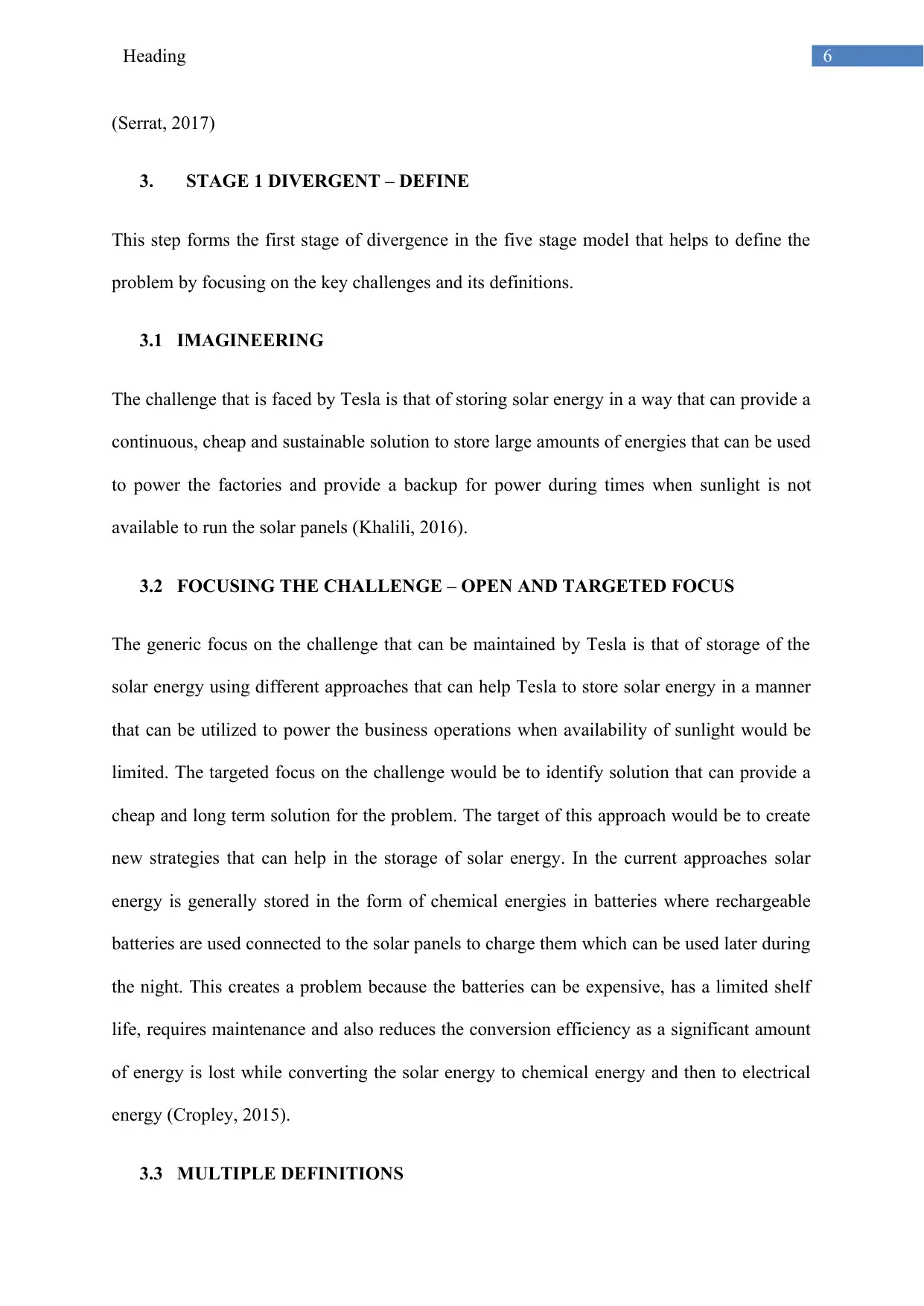
6Heading
(Serrat, 2017)
3. STAGE 1 DIVERGENT – DEFINE
This step forms the first stage of divergence in the five stage model that helps to define the
problem by focusing on the key challenges and its definitions.
3.1 IMAGINEERING
The challenge that is faced by Tesla is that of storing solar energy in a way that can provide a
continuous, cheap and sustainable solution to store large amounts of energies that can be used
to power the factories and provide a backup for power during times when sunlight is not
available to run the solar panels (Khalili, 2016).
3.2 FOCUSING THE CHALLENGE – OPEN AND TARGETED FOCUS
The generic focus on the challenge that can be maintained by Tesla is that of storage of the
solar energy using different approaches that can help Tesla to store solar energy in a manner
that can be utilized to power the business operations when availability of sunlight would be
limited. The targeted focus on the challenge would be to identify solution that can provide a
cheap and long term solution for the problem. The target of this approach would be to create
new strategies that can help in the storage of solar energy. In the current approaches solar
energy is generally stored in the form of chemical energies in batteries where rechargeable
batteries are used connected to the solar panels to charge them which can be used later during
the night. This creates a problem because the batteries can be expensive, has a limited shelf
life, requires maintenance and also reduces the conversion efficiency as a significant amount
of energy is lost while converting the solar energy to chemical energy and then to electrical
energy (Cropley, 2015).
3.3 MULTIPLE DEFINITIONS
(Serrat, 2017)
3. STAGE 1 DIVERGENT – DEFINE
This step forms the first stage of divergence in the five stage model that helps to define the
problem by focusing on the key challenges and its definitions.
3.1 IMAGINEERING
The challenge that is faced by Tesla is that of storing solar energy in a way that can provide a
continuous, cheap and sustainable solution to store large amounts of energies that can be used
to power the factories and provide a backup for power during times when sunlight is not
available to run the solar panels (Khalili, 2016).
3.2 FOCUSING THE CHALLENGE – OPEN AND TARGETED FOCUS
The generic focus on the challenge that can be maintained by Tesla is that of storage of the
solar energy using different approaches that can help Tesla to store solar energy in a manner
that can be utilized to power the business operations when availability of sunlight would be
limited. The targeted focus on the challenge would be to identify solution that can provide a
cheap and long term solution for the problem. The target of this approach would be to create
new strategies that can help in the storage of solar energy. In the current approaches solar
energy is generally stored in the form of chemical energies in batteries where rechargeable
batteries are used connected to the solar panels to charge them which can be used later during
the night. This creates a problem because the batteries can be expensive, has a limited shelf
life, requires maintenance and also reduces the conversion efficiency as a significant amount
of energy is lost while converting the solar energy to chemical energy and then to electrical
energy (Cropley, 2015).
3.3 MULTIPLE DEFINITIONS
Paraphrase This Document
Need a fresh take? Get an instant paraphrase of this document with our AI Paraphraser
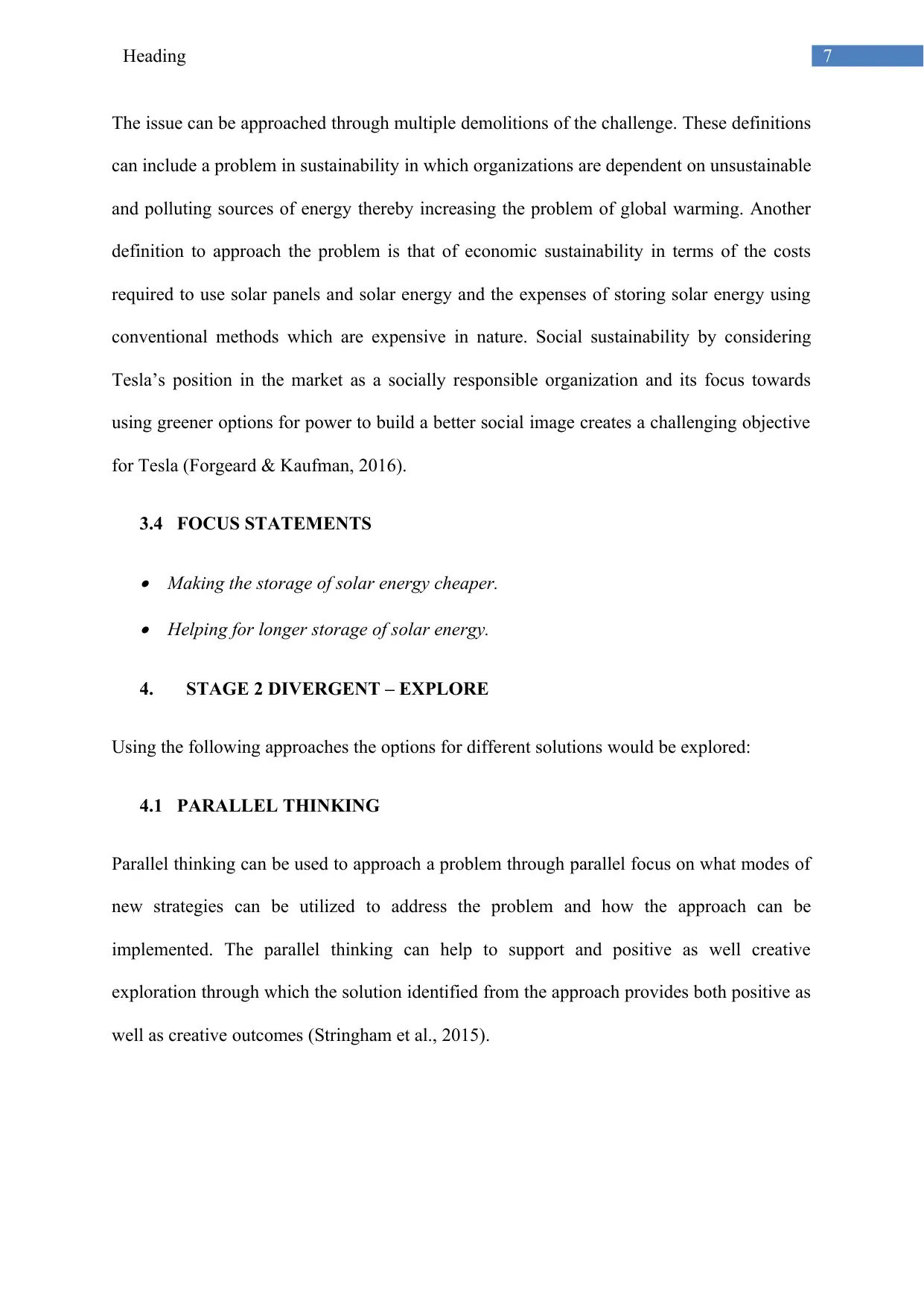
7Heading
The issue can be approached through multiple demolitions of the challenge. These definitions
can include a problem in sustainability in which organizations are dependent on unsustainable
and polluting sources of energy thereby increasing the problem of global warming. Another
definition to approach the problem is that of economic sustainability in terms of the costs
required to use solar panels and solar energy and the expenses of storing solar energy using
conventional methods which are expensive in nature. Social sustainability by considering
Tesla’s position in the market as a socially responsible organization and its focus towards
using greener options for power to build a better social image creates a challenging objective
for Tesla (Forgeard & Kaufman, 2016).
3.4 FOCUS STATEMENTS
Making the storage of solar energy cheaper. Helping for longer storage of solar energy.
4. STAGE 2 DIVERGENT – EXPLORE
Using the following approaches the options for different solutions would be explored:
4.1 PARALLEL THINKING
Parallel thinking can be used to approach a problem through parallel focus on what modes of
new strategies can be utilized to address the problem and how the approach can be
implemented. The parallel thinking can help to support and positive as well creative
exploration through which the solution identified from the approach provides both positive as
well as creative outcomes (Stringham et al., 2015).
The issue can be approached through multiple demolitions of the challenge. These definitions
can include a problem in sustainability in which organizations are dependent on unsustainable
and polluting sources of energy thereby increasing the problem of global warming. Another
definition to approach the problem is that of economic sustainability in terms of the costs
required to use solar panels and solar energy and the expenses of storing solar energy using
conventional methods which are expensive in nature. Social sustainability by considering
Tesla’s position in the market as a socially responsible organization and its focus towards
using greener options for power to build a better social image creates a challenging objective
for Tesla (Forgeard & Kaufman, 2016).
3.4 FOCUS STATEMENTS
Making the storage of solar energy cheaper. Helping for longer storage of solar energy.
4. STAGE 2 DIVERGENT – EXPLORE
Using the following approaches the options for different solutions would be explored:
4.1 PARALLEL THINKING
Parallel thinking can be used to approach a problem through parallel focus on what modes of
new strategies can be utilized to address the problem and how the approach can be
implemented. The parallel thinking can help to support and positive as well creative
exploration through which the solution identified from the approach provides both positive as
well as creative outcomes (Stringham et al., 2015).
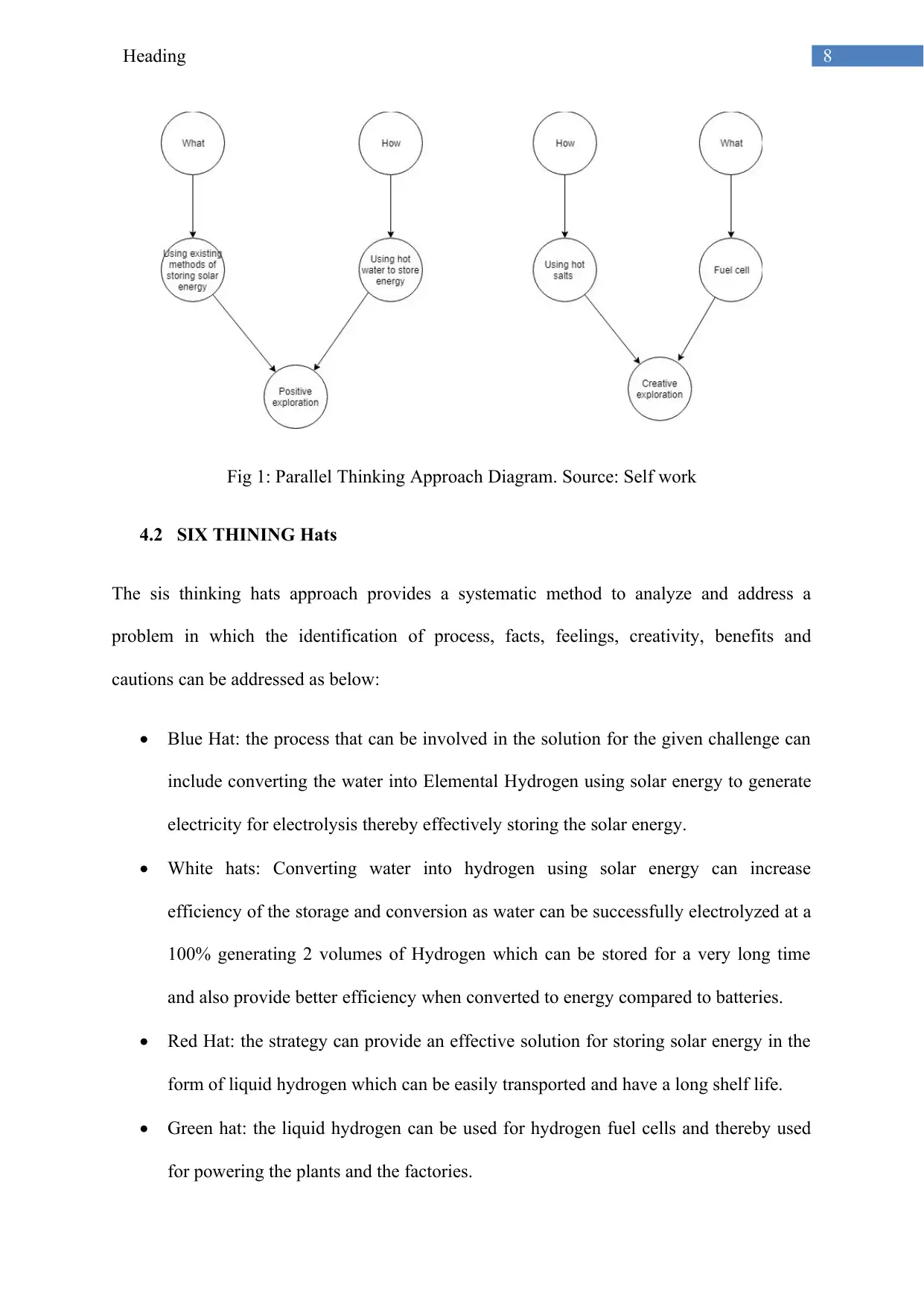
8Heading
Fig 1: Parallel Thinking Approach Diagram. Source: Self work
4.2 SIX THINING Hats
The sis thinking hats approach provides a systematic method to analyze and address a
problem in which the identification of process, facts, feelings, creativity, benefits and
cautions can be addressed as below:
Blue Hat: the process that can be involved in the solution for the given challenge can
include converting the water into Elemental Hydrogen using solar energy to generate
electricity for electrolysis thereby effectively storing the solar energy.
White hats: Converting water into hydrogen using solar energy can increase
efficiency of the storage and conversion as water can be successfully electrolyzed at a
100% generating 2 volumes of Hydrogen which can be stored for a very long time
and also provide better efficiency when converted to energy compared to batteries.
Red Hat: the strategy can provide an effective solution for storing solar energy in the
form of liquid hydrogen which can be easily transported and have a long shelf life.
Green hat: the liquid hydrogen can be used for hydrogen fuel cells and thereby used
for powering the plants and the factories.
Fig 1: Parallel Thinking Approach Diagram. Source: Self work
4.2 SIX THINING Hats
The sis thinking hats approach provides a systematic method to analyze and address a
problem in which the identification of process, facts, feelings, creativity, benefits and
cautions can be addressed as below:
Blue Hat: the process that can be involved in the solution for the given challenge can
include converting the water into Elemental Hydrogen using solar energy to generate
electricity for electrolysis thereby effectively storing the solar energy.
White hats: Converting water into hydrogen using solar energy can increase
efficiency of the storage and conversion as water can be successfully electrolyzed at a
100% generating 2 volumes of Hydrogen which can be stored for a very long time
and also provide better efficiency when converted to energy compared to batteries.
Red Hat: the strategy can provide an effective solution for storing solar energy in the
form of liquid hydrogen which can be easily transported and have a long shelf life.
Green hat: the liquid hydrogen can be used for hydrogen fuel cells and thereby used
for powering the plants and the factories.
⊘ This is a preview!⊘
Do you want full access?
Subscribe today to unlock all pages.

Trusted by 1+ million students worldwide
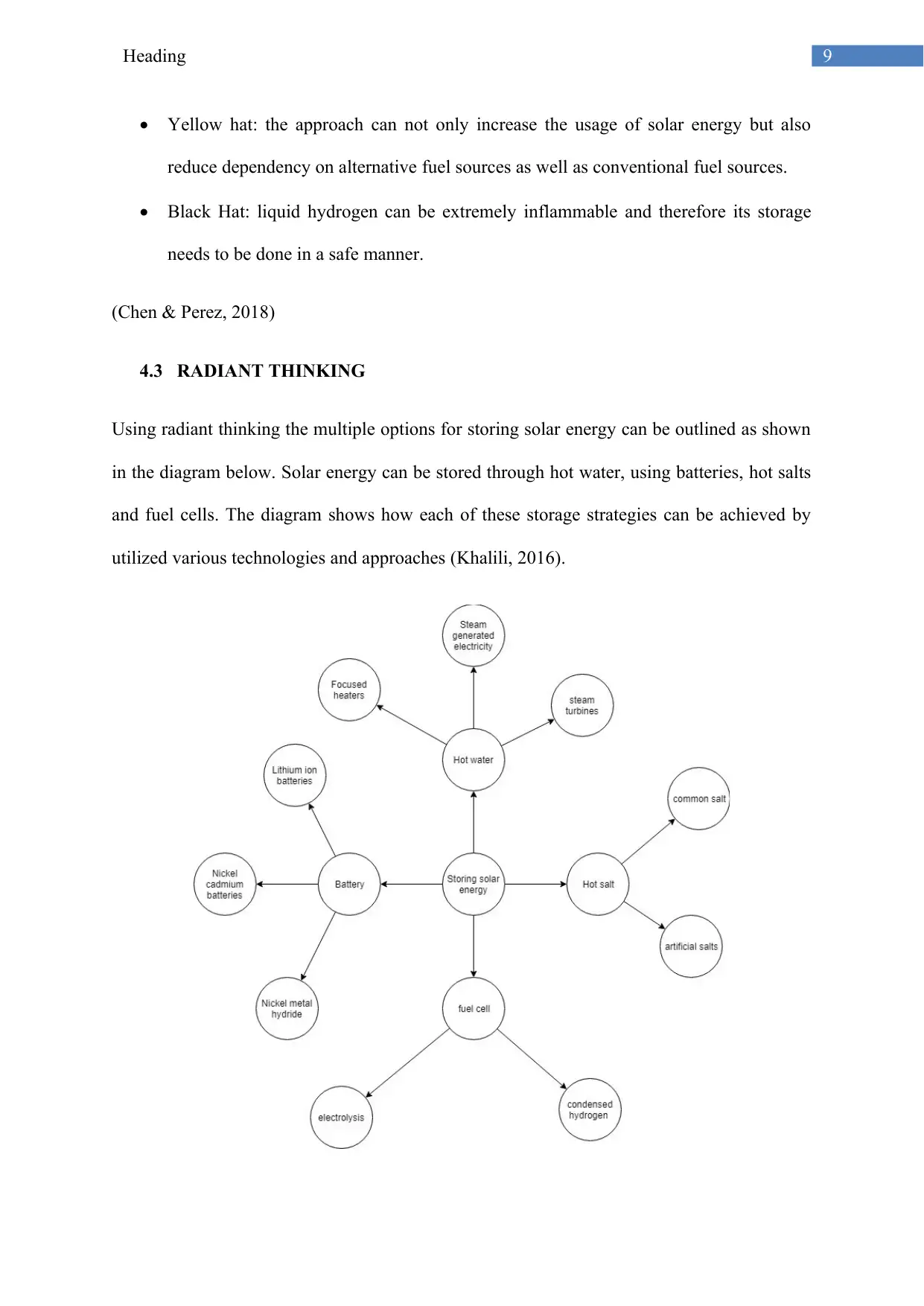
9Heading
Yellow hat: the approach can not only increase the usage of solar energy but also
reduce dependency on alternative fuel sources as well as conventional fuel sources.
Black Hat: liquid hydrogen can be extremely inflammable and therefore its storage
needs to be done in a safe manner.
(Chen & Perez, 2018)
4.3 RADIANT THINKING
Using radiant thinking the multiple options for storing solar energy can be outlined as shown
in the diagram below. Solar energy can be stored through hot water, using batteries, hot salts
and fuel cells. The diagram shows how each of these storage strategies can be achieved by
utilized various technologies and approaches (Khalili, 2016).
Yellow hat: the approach can not only increase the usage of solar energy but also
reduce dependency on alternative fuel sources as well as conventional fuel sources.
Black Hat: liquid hydrogen can be extremely inflammable and therefore its storage
needs to be done in a safe manner.
(Chen & Perez, 2018)
4.3 RADIANT THINKING
Using radiant thinking the multiple options for storing solar energy can be outlined as shown
in the diagram below. Solar energy can be stored through hot water, using batteries, hot salts
and fuel cells. The diagram shows how each of these storage strategies can be achieved by
utilized various technologies and approaches (Khalili, 2016).
Paraphrase This Document
Need a fresh take? Get an instant paraphrase of this document with our AI Paraphraser
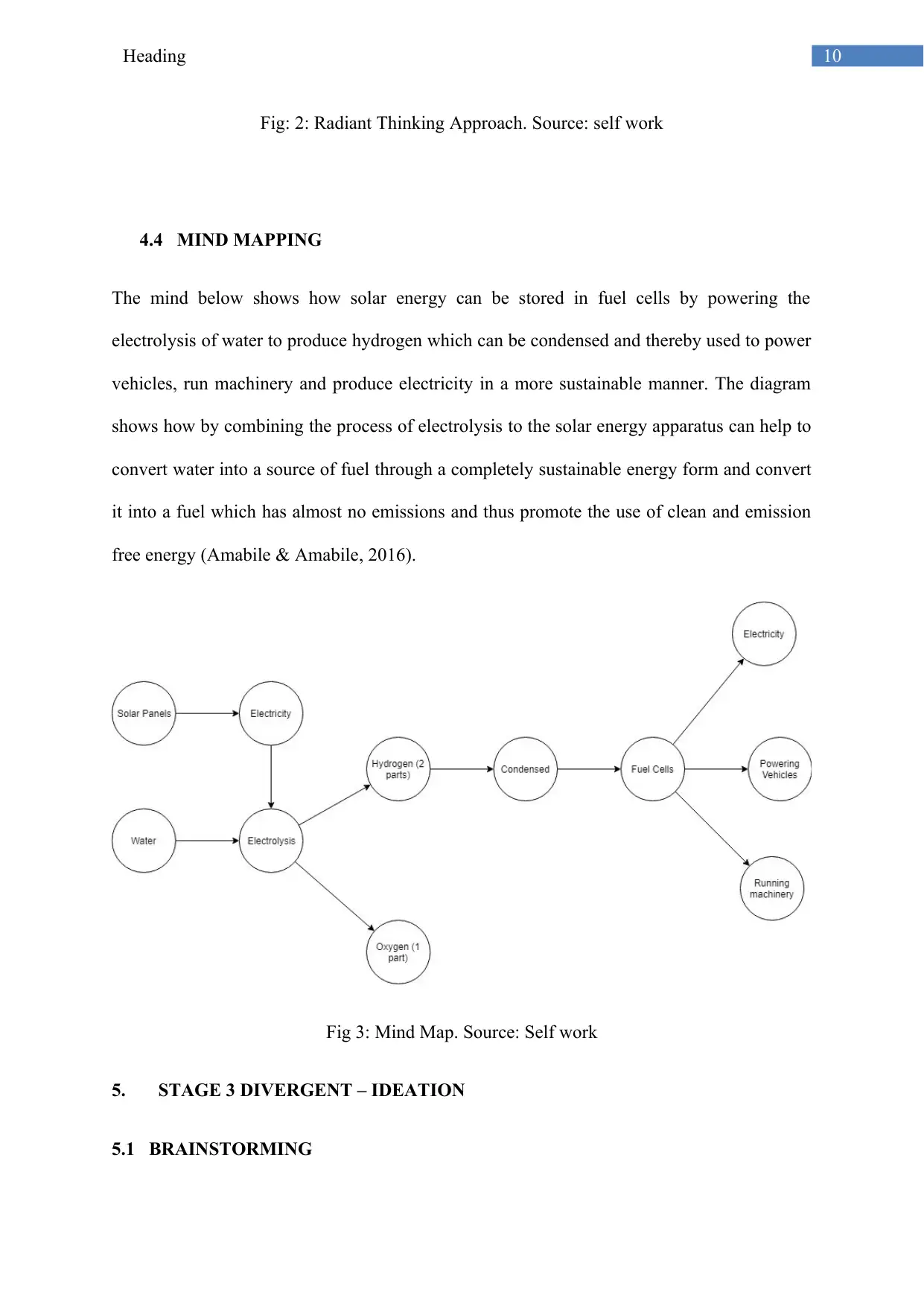
10Heading
Fig: 2: Radiant Thinking Approach. Source: self work
4.4 MIND MAPPING
The mind below shows how solar energy can be stored in fuel cells by powering the
electrolysis of water to produce hydrogen which can be condensed and thereby used to power
vehicles, run machinery and produce electricity in a more sustainable manner. The diagram
shows how by combining the process of electrolysis to the solar energy apparatus can help to
convert water into a source of fuel through a completely sustainable energy form and convert
it into a fuel which has almost no emissions and thus promote the use of clean and emission
free energy (Amabile & Amabile, 2016).
Fig 3: Mind Map. Source: Self work
5. STAGE 3 DIVERGENT – IDEATION
5.1 BRAINSTORMING
Fig: 2: Radiant Thinking Approach. Source: self work
4.4 MIND MAPPING
The mind below shows how solar energy can be stored in fuel cells by powering the
electrolysis of water to produce hydrogen which can be condensed and thereby used to power
vehicles, run machinery and produce electricity in a more sustainable manner. The diagram
shows how by combining the process of electrolysis to the solar energy apparatus can help to
convert water into a source of fuel through a completely sustainable energy form and convert
it into a fuel which has almost no emissions and thus promote the use of clean and emission
free energy (Amabile & Amabile, 2016).
Fig 3: Mind Map. Source: Self work
5. STAGE 3 DIVERGENT – IDEATION
5.1 BRAINSTORMING
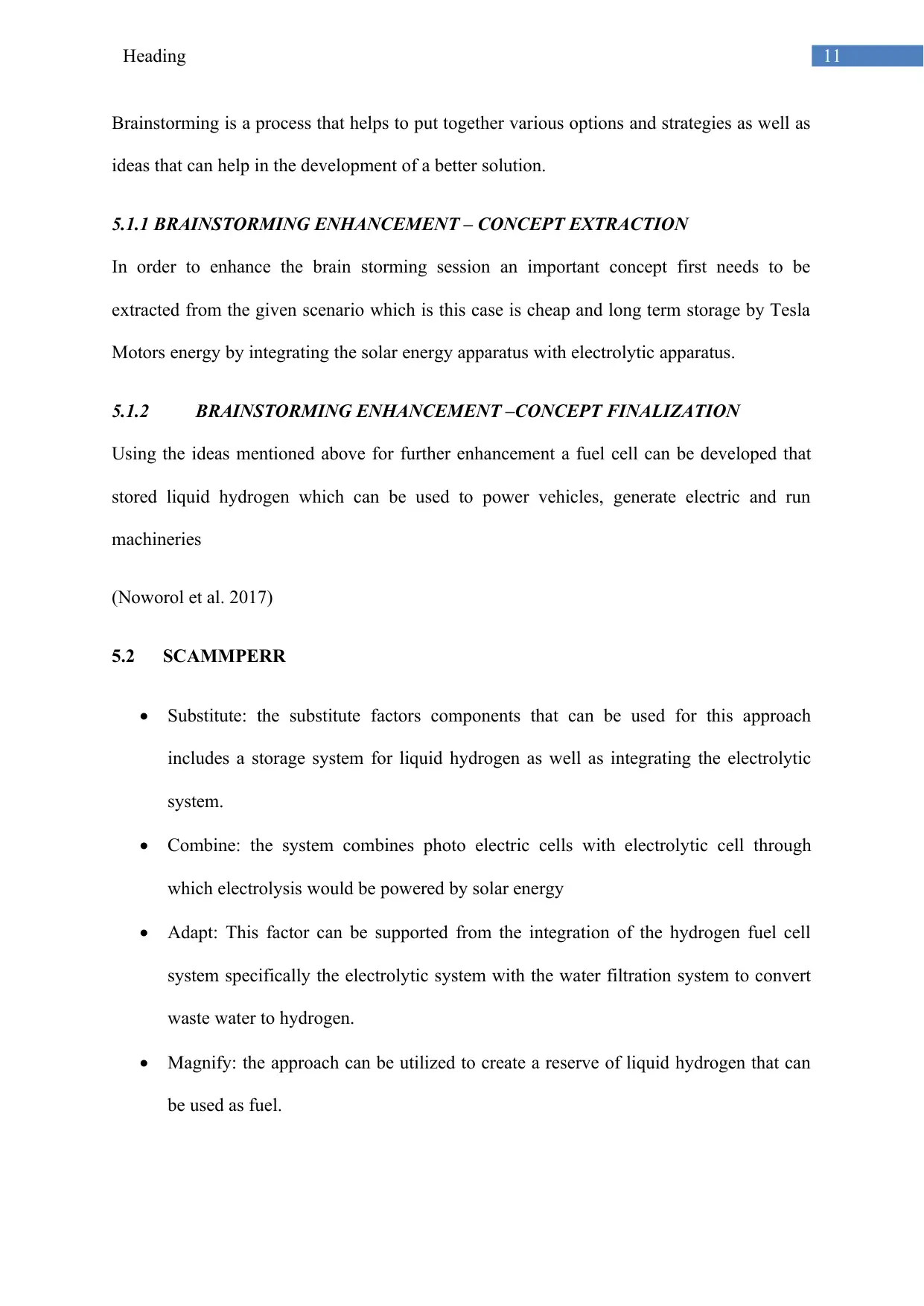
11Heading
Brainstorming is a process that helps to put together various options and strategies as well as
ideas that can help in the development of a better solution.
5.1.1 BRAINSTORMING ENHANCEMENT – CONCEPT EXTRACTION
In order to enhance the brain storming session an important concept first needs to be
extracted from the given scenario which is this case is cheap and long term storage by Tesla
Motors energy by integrating the solar energy apparatus with electrolytic apparatus.
5.1.2 BRAINSTORMING ENHANCEMENT –CONCEPT FINALIZATION
Using the ideas mentioned above for further enhancement a fuel cell can be developed that
stored liquid hydrogen which can be used to power vehicles, generate electric and run
machineries
(Noworol et al. 2017)
5.2 SCAMMPERR
Substitute: the substitute factors components that can be used for this approach
includes a storage system for liquid hydrogen as well as integrating the electrolytic
system.
Combine: the system combines photo electric cells with electrolytic cell through
which electrolysis would be powered by solar energy
Adapt: This factor can be supported from the integration of the hydrogen fuel cell
system specifically the electrolytic system with the water filtration system to convert
waste water to hydrogen.
Magnify: the approach can be utilized to create a reserve of liquid hydrogen that can
be used as fuel.
Brainstorming is a process that helps to put together various options and strategies as well as
ideas that can help in the development of a better solution.
5.1.1 BRAINSTORMING ENHANCEMENT – CONCEPT EXTRACTION
In order to enhance the brain storming session an important concept first needs to be
extracted from the given scenario which is this case is cheap and long term storage by Tesla
Motors energy by integrating the solar energy apparatus with electrolytic apparatus.
5.1.2 BRAINSTORMING ENHANCEMENT –CONCEPT FINALIZATION
Using the ideas mentioned above for further enhancement a fuel cell can be developed that
stored liquid hydrogen which can be used to power vehicles, generate electric and run
machineries
(Noworol et al. 2017)
5.2 SCAMMPERR
Substitute: the substitute factors components that can be used for this approach
includes a storage system for liquid hydrogen as well as integrating the electrolytic
system.
Combine: the system combines photo electric cells with electrolytic cell through
which electrolysis would be powered by solar energy
Adapt: This factor can be supported from the integration of the hydrogen fuel cell
system specifically the electrolytic system with the water filtration system to convert
waste water to hydrogen.
Magnify: the approach can be utilized to create a reserve of liquid hydrogen that can
be used as fuel.
⊘ This is a preview!⊘
Do you want full access?
Subscribe today to unlock all pages.

Trusted by 1+ million students worldwide
1 out of 17
Related Documents
Your All-in-One AI-Powered Toolkit for Academic Success.
+13062052269
info@desklib.com
Available 24*7 on WhatsApp / Email
![[object Object]](/_next/static/media/star-bottom.7253800d.svg)
Unlock your academic potential
Copyright © 2020–2025 A2Z Services. All Rights Reserved. Developed and managed by ZUCOL.





